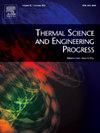增材制造微通道换热器热性能的实验与数值研究
IF 5.1
3区 工程技术
Q2 ENERGY & FUELS
引用次数: 0
摘要
高效换热器是提高微型燃气轮机热效率的关键。本文采用模块化设计思想,设计了一种先进的微通道换热器。采用增材制造技术(AM)制作了换热器单元,并在各种工况下进行了稳态热性能实验。AM微通道换热器具有波浪形微通道的特点,波纹状的主壁上设置了交错的微厚度支撑肋,支撑肋横跨波浪形微通道的高度,微肋的作用是增加受潮面积,实现微通道内的均匀流动分布。AM热交换器密实度超过1700 m2/m3,工业CT扫描显示除了峰值崩塌外,质量相对较高。实验表明,在雷诺数200 ~ 600范围内,AM换热器的最大换热效率为0.78,压力损失保持在进口总压的3.0%以下,平均努塞尔数比传统平板换热器提高了约88.9%。数值模拟进一步揭示了微通道换热器高热性能背后的流动机制。由于波浪壁面上有规律的流动波动和沿波浪状微通道的微肋的导流作用,增强的换热在通道内均匀分布。在波纹壁面的波峰和波谷处形成明显的涡结构,入口的突然收缩和出口的突然膨胀造成了额外的压力损失。通过数值模拟与实验数据的对比,可以看出增材制造换热器固有的表面粗糙度增强了换热性能,但也导致了更大的压力损失。本文章由计算机程序翻译,如有差异,请以英文原文为准。
Experimental and numerical study of thermal performance of an additively manufactured microchannel heat exchanger
High-efficiency heat exchangers (HX) play a pivotal role in enhancing the thermal efficiency of micro gas turbines. This study presents an advanced microchannel heat exchanger which was specifically designed adopting a modular design concept. A unit of the heat exchanger was fabricated using additive manufacturing (AM), and steady-state thermal performance experiments were carried out under various operational conditions. The AM microchannel heat exchanger is characterized by wavy microchannels, and the corrugated primary walls are equipped with staggered micro-thickness supporting ribs spanning the height of the wavy microchannels, and the micro ribs work to increase the wetted area and achieve a uniform flow distribution within the microchannels. The AM heat exchanger exhibits compactness exceeding 1700 m2/m3, and industrial CT scanning reveals relatively high-quality except for the collapse of the peaks. Experiments show that the AM heat exchanger achieves a maximum heat transfer efficiency of 0.78 within the Reynolds numbers range of 200–600, and maintains a pressure loss below 3.0 % of the inlet total pressure, which shows about 88.9 % improvement in the average Nusselt numbers compared to conventional flat-plate heat exchangers. Numerical simulations further reveal the flow mechanisms behind the high thermal performance of the microchannel heat exchanger. Due to the regular flow fluctuations over the wavy walls and the flow guiding effects by the micro ribs along the wavy microchannels, the enhanced heat transfer is uniformly distributed across the channels. Apparent vortex structures are formed at the crests and troughs of the corrugated walls, and the sudden contraction at the inlet and expansion at the outlet contribute to additional pressure loss. Through comparing numerical simulations with the experimental data, it is evident that the inherent surface roughness of additive manufactured heat exchanger enhances heat transfer but also leads to greater pressure loss.
求助全文
通过发布文献求助,成功后即可免费获取论文全文。
去求助
来源期刊

Thermal Science and Engineering Progress
Chemical Engineering-Fluid Flow and Transfer Processes
CiteScore
7.20
自引率
10.40%
发文量
327
审稿时长
41 days
期刊介绍:
Thermal Science and Engineering Progress (TSEP) publishes original, high-quality research articles that span activities ranging from fundamental scientific research and discussion of the more controversial thermodynamic theories, to developments in thermal engineering that are in many instances examples of the way scientists and engineers are addressing the challenges facing a growing population – smart cities and global warming – maximising thermodynamic efficiencies and minimising all heat losses. It is intended that these will be of current relevance and interest to industry, academia and other practitioners. It is evident that many specialised journals in thermal and, to some extent, in fluid disciplines tend to focus on topics that can be classified as fundamental in nature, or are ‘applied’ and near-market. Thermal Science and Engineering Progress will bridge the gap between these two areas, allowing authors to make an easy choice, should they or a journal editor feel that their papers are ‘out of scope’ when considering other journals. The range of topics covered by Thermal Science and Engineering Progress addresses the rapid rate of development being made in thermal transfer processes as they affect traditional fields, and important growth in the topical research areas of aerospace, thermal biological and medical systems, electronics and nano-technologies, renewable energy systems, food production (including agriculture), and the need to minimise man-made thermal impacts on climate change. Review articles on appropriate topics for TSEP are encouraged, although until TSEP is fully established, these will be limited in number. Before submitting such articles, please contact one of the Editors, or a member of the Editorial Advisory Board with an outline of your proposal and your expertise in the area of your review.
 求助内容:
求助内容: 应助结果提醒方式:
应助结果提醒方式:


